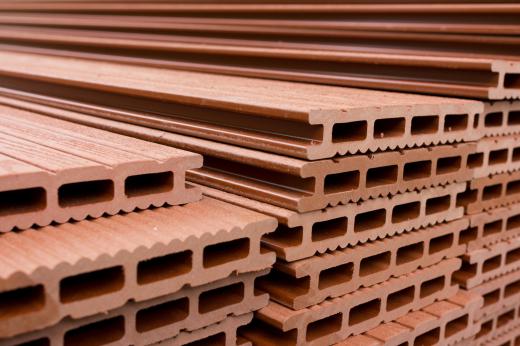What are Composite Materials?
 Mary McMahon
Mary McMahon
Composite materials for construction, engineering, and other similar applications are formed by combining two or more materials in such a way that the constituents are still distinguishable and not fully blended. One example is concrete, which uses cement as a binding material in combination with aggregate, like gravel, as a reinforcement. In many cases, concrete uses rebar as a second reinforcement, making it a three-phase composite, because of the three elements involved.
This type of material takes advantage of the different strengths and abilities of its different elements. In the case of mud and straw bricks, for example, mud is an excellent binding material, but it cannot stand up to compression and force well. Straw, on the other hand, is well able to withstand compression without crumbling or breaking, and so it serves to reinforce the binding action of the mud. Humans have been creating composite materials to build stronger and lighter objects for thousands of years.

The majority of composite materials use two constituents: a binder or matrix and a reinforcement. The reinforcement is stronger and stiffer, forming a sort of backbone, while the matrix keeps the reinforcement in a set place. The binder also protects the reinforcement, which may be brittle or breakable, as in the case of the long glass fibers used in conjunction with plastics to make fiberglass. Generally, composites have excellent compressibility combined with good tensile strength, making them versatile in a wide range of situations.

Engineers building anything, from a patio to an airplane, look at the unique stresses that their construction will undergo. Extreme changes in temperature, external forces, and water or chemical erosion are all accounted for in an assessment of needs. When building an aircraft, for example, engineers need lightweight, strong material that can insulate and protect passengers while surfacing the aircraft. An aircraft made of pure metal could fail catastrophically if a small crack appeared in the skin of the airplane. On the other hand, one integrating reinforced materials such as fiberglass, graphite, and other hybrids will be stronger and less likely to break up at stress points in situations involving turbulence.

Many composites are made in layers or plies, with a woven fiber reinforcement sandwiched between layers of plastic or another similar binder. These materials have the advantage of being very moldable, as in the hull of a fiberglass boat. Composites have revolutionized a number of industries, especially the aviation industry, in which the development of higher quality materials allows companies to build bigger and better aircraft.
AS FEATURED ON:
AS FEATURED ON:















Discussion Comments
What are the uses of composite materials in the engineering?
What is a layered material and how is it different from composite?
How do composite toe safety shoes compare to steel toe safety shoes?
Please tell me any projects on the composite materials.
what are different applications of composite materials?
Are you able to replace steel bumpers in an automobile with a composite one and is it an advantage and what role does it play?
what are the main design aspects?
Any recycle composite material available or not?
Alternative material for NFTC Natural Fiber Thermoset Composite. It is used in railway coach roofs.
what are the uses of composite materials in the engineering industry?
i want to know more examples of recycled composite materials.
future of composite materials?
i want know any complete project on the composite material.
Alloy always consists of two metals and one of them should lose its identity and dissolve in the other. But in composites, which is also the combination of two materials, neither substance will lose its identity (no change in atomic structure). -nani
i want to build a prototype of an automobile made of composites.
I want know any projects on the composite materials
please tell me any projects on the composite materials
is composite materials combination of metals and non metals? can an alloy be called a composite material?
the uses of composite materials in engineering industry?
Post your comments